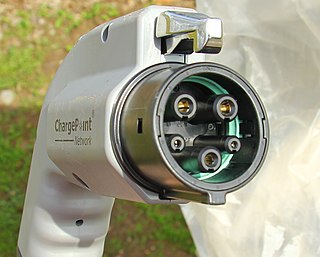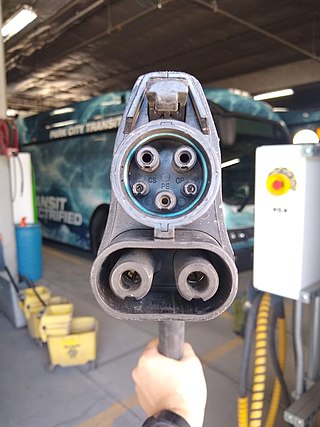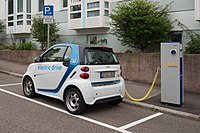
Vehicle-to-grid (V2G) describes a system in which plug-in electric vehicles (PEV) sell demand response services to the grid. Demand services are either delivering electricity or reducing their charging rate. Demand services reduce pressure on the grid, which might otherwise experience disruption from load variations. Vehicle-to-load (V2L) and Vehicle-to-vehicle (V2V) are related, but the AC phase is not sychronised with the grid, so the power is only available to an "off grid" load.

A charging station, also known as a charge point, chargepoint, or electric vehicle supply equipment (EVSE), is a power supply device that supplies electrical power for recharging plug-in electric vehicles.

SAE J1772, also known as a J plug or Type 1 connector after its international standard, IEC 62196 Type 1, is a North American standard for electrical connectors for electric vehicles maintained by SAE International under the formal title "SAE Surface Vehicle Recommended Practice J1772, SAE Electric Vehicle Conductive Charge Coupler".

CHAdeMO is a fast-charging system for battery electric vehicles, developed in 2010 by the CHAdeMO Association, formed by the Tokyo Electric Power Company and five major Japanese automakers. The name is an abbreviation of "CHArge de MOve" and is derived from the Japanese phrase "o CHA deMO ikaga desuka" (お茶でもいかがですか), translating to English as "How about a cup of tea?", referring to the time it would take to charge a car.

IEC 62196Plugs, socket-outlets, vehicle connectors and vehicle inlets – Conductive charging of electric vehicles is a series of international standards that define requirements and tests for plugs, socket-outlets, vehicle connectors and vehicle inlets for conductive charging of electric vehicles and is maintained by the technical subcommittee SC 23H “Plugs, Socket-outlets and Couplers for industrial and similar applications, and for Electric Vehicles” of the International Electrotechnical Commission (IEC).
The UCLA Smart Grid Energy Research Center (SMERC), located on the University of California Los Angeles (UCLA) campus, is an organization focused on developing the next generation of technologies and innovation for Smart Grid. SMERC partners with government agencies, technology providers, Department of Energy (DOE) research labs, universities, utilities, policymakers, electric vehicle manufacturers, and appliance manufacturers. These partnerships provide SMERC with diverse capabilities and exceptional, mature leadership.

The Combined Charging System (CCS) is a standard for charging electric vehicles. It can use Combo 1 (CCS1) or Combo 2 (CCS2) connectors to provide power at up to 350 kilowatts (kW) . These two connectors are extensions of the IEC 62196 Type 1 and Type 2 connectors, with two additional direct current (DC) contacts to allow high-power DC fast charging. In response to demand for faster charging, 400 kW CCS chargers have been deployed by charging networks and 700 kW CCS chargers have been demonstrated.

The IEC 62196 Type 2 connector is used for charging electric vehicles, mainly within Europe, as it was declared standard by the EU. Based on widespread red IEC 60309 three phase plugs with five pins, which come in different diameters according to maximum current, a single size was selected, as maximum possible power will be communicated to the car via two additional communication pins and by a simple resistor coding within the cable. The onboard charger inside the car has to limit the current accordingly.
The electric vehicle industry in India is slowly growing. The central and state governments have implemented schemes and incentives to promote electric mobility, and have introduced regulations and standards.
IEC 63110 is an international standard defining a protocol for the management of electric vehicles charging and discharging infrastructures, which is currently under development. IEC 63110 is one of the International Electrotechnical Commission's group of standards for electric road vehicles and electric industrial trucks, and is the responsibility of Joint Working Group 11 (JWG11) of IEC Technical Committee 69 (TC69).

IEC 61851 is an international standard for electric vehicle conductive charging systems, parts of which are currently still under development(written 2017). IEC 61851 is one of the International Electrotechnical Commission's group of standards for electric road vehicles and electric industrial trucks and is the responsibility of IEC Technical Committee 69 (TC69).

SAE J3068 "Electric Vehicle Power Transfer System Using a Three-Phase Capable Coupler" is a North American recommended practice published and maintained by SAE International. J3068 defines electrical connectors and a control protocol for electric vehicles. It has the formal title "SAE Surface Vehicle Recommended Practice J3068". J3068 defines a system of conductive power transfer to an electric vehicle using a coupler capable of transferring single-phase and three-phase AC power as well as DC power, and defines a digital communication system for control. J3068 also specifies requirements for the vehicle inlet, supply equipment connector, mating housings and contacts.

Electrify America, LLC is electric vehicle DC fast-charging network in the United States, with more than 850 stations and over 3,700 connectors as of December 2023. It is a subsidiary of Volkswagen Group of America, established in late 2016 by the automaker as part of its efforts to offset emissions in the wake of the Volkswagen emissions scandal. Volkswagen, as part of its settlement following the "Dieselgate" emissions scandal, invested $2 billion in creating Electrify America. In June 2022, Siemens became a minority shareholder of the company. Electrify America supports the CCS and CHAdeMO connector types with plans to add NACS connectors starting in 2025. Electrify America has been the target of significant criticism for the perceived lack of reliability and maintenance of its stations.

Smart charging refers to a charging system where electric vehicles, charging stations and charging operators share data connections. Through smart charging, the charging stations may monitor, manage, and restrict the use of charging devices to optimize energy consumption. Comparing with uncontrolled charging, smart charging will flatten the electricity usage peak by shifting the peak due to vehicle charging away from the peak due to other consumption.
The GB/T charging standard is a set of GB/T standards, primarily in the GB/T 20234 family, for electric vehicle AC and DC fast charging used in China. The standards were revised and updated most recently in 2015 by the Standardization Administration of China. The term is an abbreviation of 国标推荐 (guóbiāo/tuījiàn), translated as "recommended/voluntary national standard".

The ChaoJi connector, also referenced as CHAdeMO 3.0, is an ultra-high-power charging standard charging electric cars, released in 2020. The connector has a lemniscate shape (∞), with a flat bottom edge and is planned for charging battery electric vehicles at up to 900 kilowatts using direct current. The design incorporates backward compatibility with CHAdeMO and the GB/T DC-charging, using a dedicated inlet adapter for each system. The circuit interface of ChaoJi is also designed to be fully compatible with the Combined Charging System, also known as CCS.

Electrify Canada is a corporation formed by Electrify America and Volkswagen Group to build electric vehicle (EV) direct current (DC) charging infrastructure in Canada.

The Megawatt Charging System (MCS) is a charging connector under development for large battery electric vehicles. The connector will be rated for charging at a maximum rate of 3.75 megawatts.

The IEC 62196 Type 3 connector is used for charging battery electric vehicles, mainly within France and Italy, as it was one of three AC plug standards described in IEC 62196-2. The Type 3 connector comes in two physical formats, Type 3A for single-phase (230V) and Type 3C for single- and three-phase (400V) alternating current (AC) power. Both have since been superseded by the Type 2 connector, the latter adopted as sole connector in 2013 by the European Union. The Type 1 connector is the corresponding AC connector standard used in North America, Japan, and South Korea.

The North American Charging Standard (NACS), currently being standardized as SAE J3400 and also known as the Tesla charging standard, is an electric vehicle (EV) charging connector system developed by Tesla, Inc. It has been used by all North American market Tesla vehicles since 2021 and was opened for use by other manufacturers in November 2022. It is backwards compatible with the proprietary Tesla connectors made before 2021.
















